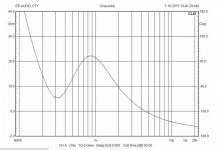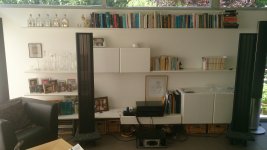Is this possible or is my hearing wrong. Could it be the casing, or the on off switch?
That was the only change.
Ha, it seams it was a bad on off switch, i took it out and now its fine again
I used a 19v 1,5A Asus PC switching power supply. And a 3 lead toggle switch.
The switch was leaking(shorting), i discovered a strange hiss from the switching power supply yesterday and promptly took it out.
Now i use a 12v 17A SLA battery with a 2 lead on/off switch on the + cable.
The Wiener now sound even better than when i first used it unboxed with a 2 lead on/off switch and the 19v Asus switching power supply.
My bad, i almost killed the power supply so its amazing the Wiener did not burn, must be some dang good protection circutry in there puuhh...
The switch was leaking(shorting), i discovered a strange hiss from the switching power supply yesterday and promptly took it out.
Now i use a 12v 17A SLA battery with a 2 lead on/off switch on the + cable.
The Wiener now sound even better than when i first used it unboxed with a 2 lead on/off switch and the 19v Asus switching power supply.
My bad, i almost killed the power supply so its amazing the Wiener did not burn, must be some dang good protection circutry in there puuhh...
Last edited:
Hello Gmarsh,
I like very much my "The Wiener" and it sounds fantastic with my dinamic speakers, creating a wall of sound that I really like.
As wrote in other messages, I also use it with my electrostatic cells:
Mini Panels
that works from 200hz to the top end but there are a lot of problems of resonance and the sound have some distortion.
I've the 8 ohm version.
Now Rob Mackinlay from ERAudio have sent me the impedence reponse that I've attached.
Do you have any suggestion to solve my problem?
Thanks for your patience.
Guglielmo
Italy
I like very much my "The Wiener" and it sounds fantastic with my dinamic speakers, creating a wall of sound that I really like.
As wrote in other messages, I also use it with my electrostatic cells:
Mini Panels
that works from 200hz to the top end but there are a lot of problems of resonance and the sound have some distortion.
I've the 8 ohm version.
Now Rob Mackinlay from ERAudio have sent me the impedence reponse that I've attached.
Do you have any suggestion to solve my problem?
Thanks for your patience.
Guglielmo
Italy
Attachments
That's an ugly load for a class D amp without post filter feedback. Try putting around 2 ohms of series resistance between the amp and the speakers - this won't be a perfect fix, but if it gets rid of resonances then at least it's a clue.
When I'm able to, I'll try and come up with a more suitable matching network to go between the card and that speaker, and/or suggest a different output filter design.
Sent from my Nexus 4 using Tapatalk
When I'm able to, I'll try and come up with a more suitable matching network to go between the card and that speaker, and/or suggest a different output filter design.
Sent from my Nexus 4 using Tapatalk
Hadn't tried this 3118 with electrostatic hybrids, but some failing blue Elna's gave the little Wiener a shot at fame. it is above the PSU next to the cdplayers, you see the green Phoenix terminal, probably. The blue Elna's for size next to little amp 
No problem whatsoever, better bass than "failing" amp, better treble too, can reach serious level with the ~80dB speakers more easily than "failing" amp too, which is (was) specced at 2x340w @2 ohm.
So better try with removed coil/cap I would say, outputfilter 3118 here for 4 ohm btw.
No problem whatsoever, better bass than "failing" amp, better treble too, can reach serious level with the ~80dB speakers more easily than "failing" amp too, which is (was) specced at 2x340w @2 ohm.
So better try with removed coil/cap I would say, outputfilter 3118 here for 4 ohm btw.
Attachments
I do have a question. Protection bahavior is different from other 3116 amps I have. It seems like ampboard restarts, takes like a second for sound to return, the 3116's mute like a fraction of a fraction of a split second in comparison. Is it the microprocessor on Wiener? Btw only other stereo btl 3116 I tried for longer time on similar speakers was a slightly modded ac1308/audiobah, that could not reach same soundlevel as Wiener, but protection tripped on high frequency bursts, treble peaks in music. The Wiener protection trips on lasting bass bursts, low frequency peaks in music, funny difference too.
Yep, in the event of a fault the microcontroller keeps the TPA off for the startup delay. Upon sensing /FAULT it instantly lowers SDZ, raises MUTE, raises SDZ again after a short period of time, then lowers MUTE after the startup delay. This delay's set by the SU DLY pot on the card.
Two reasons for this - figure 31 in the datasheet seems to recommend keeping the amp off for minimum 1.4 seconds in a fault. There's no explanation behind the figure, but I think a timed off time can't hurt anything certainly. And secondly if you just connect together SDZ/FAULT and you drive a strong LF signal into say a 2 ohm load, the amplifier instantaneously clearing its own fault and unmuting will cause a loud BRRAAAAAP which probably isn't good for your speakers.
Two reasons for this - figure 31 in the datasheet seems to recommend keeping the amp off for minimum 1.4 seconds in a fault. There's no explanation behind the figure, but I think a timed off time can't hurt anything certainly. And secondly if you just connect together SDZ/FAULT and you drive a strong LF signal into say a 2 ohm load, the amplifier instantaneously clearing its own fault and unmuting will cause a loud BRRAAAAAP which probably isn't good for your speakers.
Sofar all protections tripping here has been noiseless on all 3116's. I suspected duration was controlled, nice, now still wondering about bass causing it, that is unique here. Yes panel alone drops below 2 ohms and bass is in parallel with stereo btl ampboards like Wiener, so load is very easy 
Yeah, if you've got a sub-2 ohm load, that's your problemSofar all protections tripping here has been noiseless on all 3116's. I suspected duration was controlled, nice, now still wondering about bass causing it, that is unique here. Yes panel alone drops below 2 ohms and bass is in parallel with stereo btl ampboards like Wiener, so load is very easy
Maybe when I feel up to it I try with tone generator again(first time for Wiener)(when home alone). The bass could also be very close to maximum output 3118, my Wiener needs 26dB gainsetting (probably just for personal piece of mind), volume setting is very high indeed remembering that 6dB difference. (all 3116 set at 20dB gain here). Dc offset protection isn't the trigger btw, probably needless to say, but checked again anyway.
Internal temperature is getting most likely, I will try a vent to see if that makes a difference, that is most painless/easiest thing to try
Internal temperature is getting most likely, I will try a vent to see if that makes a difference, that is most painless/easiest thing to try
Pretty confident it's a overcurrent trip.
There's 15C of thermal hysteresis in the TPA chip and plenty of thermal mass in the PCB - I'd imagine the board would switch on/off much more slowly than the quick stop/reset you're describing.
Though if the chip does heat up, the Rds(on) of the chip's output FETs will increase with die temperature - this effectively lowers the overcurrent trip point, as the TPA does overcurrent protection by measuring voltage across its FETs. Since you're running a 2 ohm load you're going to be heating up the chip and pushing high peak currents through it.
Maybe it's time to pick up a couple PBTL boards
There's 15C of thermal hysteresis in the TPA chip and plenty of thermal mass in the PCB - I'd imagine the board would switch on/off much more slowly than the quick stop/reset you're describing.
Though if the chip does heat up, the Rds(on) of the chip's output FETs will increase with die temperature - this effectively lowers the overcurrent trip point, as the TPA does overcurrent protection by measuring voltage across its FETs. Since you're running a 2 ohm load you're going to be heating up the chip and pushing high peak currents through it.
Maybe it's time to pick up a couple PBTL boards
(Mascot http://www.mascot.no/admin/common/getimg.asp?FileID=1063)
Oscons measure little less capacitance, 70.1uF both, esr 0.01. Chemicons funny enough old fashioned above rated capacitance, also both 570uF, esr 0.01 and sometimes jumping to 0.02 ohms, meter isn't more accurate.
FPCAP replacements measure 90.0uF both, esr 0.00. Chemicons like smaller 470uFs well above rated capacitance, both 4374uF, I don't know why so high, esr 0.00. Meter can't measure esr more accurately, datasheet 7mOhms and 15mOhms.
Bass in music also today can't trigger protection like befor. Noticed Sagami inductors remain cooler playing loud too now. Again, load is difficult, low efficient and low impedance, I couldn't detect inductor temperature rise on easier speakers earlier. Difference on these speakers is ~10 degrees Celsius, 10 now or 20 earlier above room, not real high/hot. (Even the 35A Wurths get a little above roomtemperature with these speakers).
So capacitance or esr gives different protection behavior and different temperature in inductors. There are other differences some will only believe when seen measured.
Oscons measure little less capacitance, 70.1uF both, esr 0.01. Chemicons funny enough old fashioned above rated capacitance, also both 570uF, esr 0.01 and sometimes jumping to 0.02 ohms, meter isn't more accurate.
FPCAP replacements measure 90.0uF both, esr 0.00. Chemicons like smaller 470uFs well above rated capacitance, both 4374uF, I don't know why so high, esr 0.00. Meter can't measure esr more accurately, datasheet 7mOhms and 15mOhms.
Bass in music also today can't trigger protection like befor. Noticed Sagami inductors remain cooler playing loud too now. Again, load is difficult, low efficient and low impedance, I couldn't detect inductor temperature rise on easier speakers earlier. Difference on these speakers is ~10 degrees Celsius, 10 now or 20 earlier above room, not real high/hot. (Even the 35A Wurths get a little above roomtemperature with these speakers).
So capacitance or esr gives different protection behavior and different temperature in inductors. There are other differences some will only believe when seen measured.
- Home
- Group Buys
- "The Wiener" TPA3118 amplifier card

